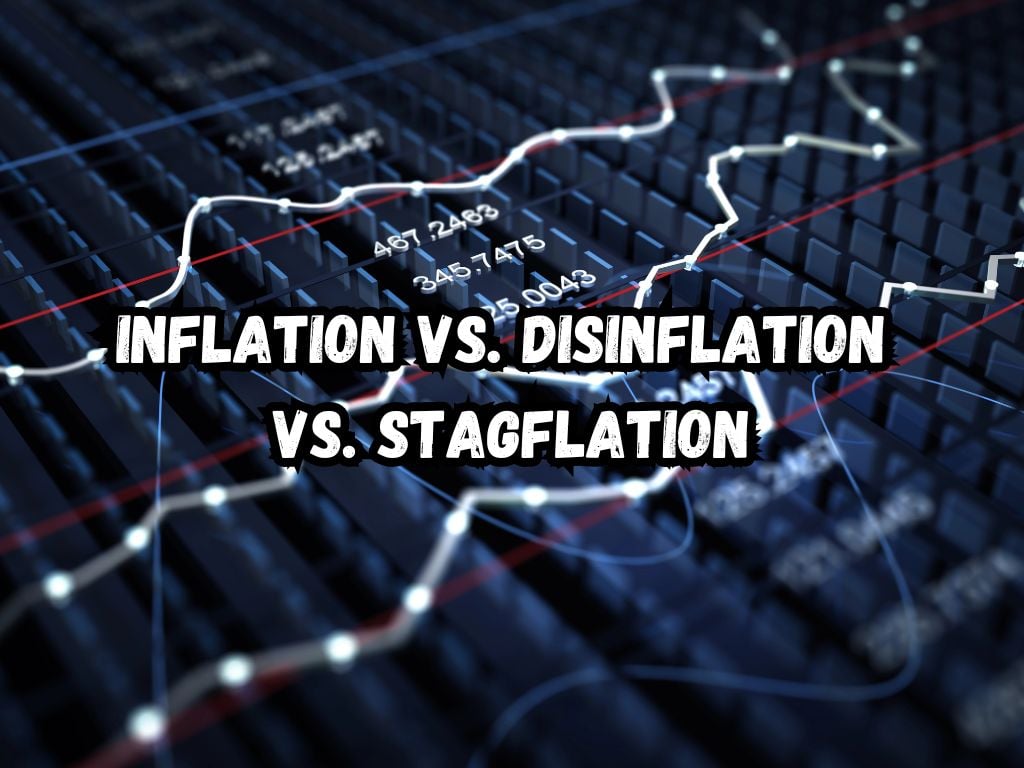In the world of economics, three terms frequently surface to describe prevailing market conditions: inflation, disinflation, and stagflation.
Each term paints a different picture of the economic landscape, impacting decisions made by policymakers, investors, and everyday consumers.
Understanding the nuances between inflation vs disinflation vs stagflation is essential for navigating the complexities of personal and national finance.
Understanding Inflation
Inflation signifies an increase in the prices of goods and services over time, reflecting a decrease in purchasing power.
It’s most commonly measured by the Consumer Price Index (CPI) and the Wholesale Price Index (WPI), which track the price changes of a selected basket of consumer goods and commodities, respectively.
The roots of inflation often lie in either demand-pull dynamics, where demand outstrips supply, or cost-push factors, where production costs rise, pushing up final prices.
While inflation hints at an active, growing economy, it reduces the value of money, affecting savings and living costs.
Therefore, understanding inflation is crucial for anyone trying to make informed financial decisions.

Exploring Disinflation
Disinflation occurs when the rate of inflation slows over a period. It is not to be confused with deflation, which is a decrease in the general price level of goods and services.
Disinflation signals a cooling economy but not necessarily a contracting one. Its causes are varied, including reduced government spending or increased interest rates.
The main indicator of disinflation is a gradual decrease in the CPI. For policymakers, disinflation can be a sign to adjust economic strategies to avoid deflation.
For individuals, it means a slower erosion of purchasing power, providing some stability in planning future expenses.
Unraveling Stagflation
Stagflation is a troublesome scenario combining stagnant economic growth, high unemployment, and high inflation.
It defies the usual economic theory that inflation and unemployment are inversely related. Historical examples, such as the 1970s in several western economies, showcase the challenging nature of stagflation.
Causes include a sudden increase in the price of essential goods, such as oil, without a corresponding increase in wages.
Stagflation presents a conundrum for policymakers: tackling inflation may increase unemployment, and stimulating the economy might worsen inflation.
Inflation vs Disinflation vs Stagflation
While inflation and disinflation indicate changes in the rate of price increases, stagflation is a more complex phenomenon, signifying no growth alongside inflation.
Inflation represents growing economic activity, disinflation signals a controlled environment where price increases are slowing, and stagflation is indicative of an economy facing concurrent issues of non-growth and rising prices.

Key Notes
Understanding these concepts is vital. Inflation, while eroding purchasing power, suggests economic expansion.
Disinflation is a sign of economic control, slowing down inflation without reducing prices.
Stagflation, however, poses significant challenges, revealing an economy struggling with both stagnation and price increases.
Pro Tips
For investors, protecting a portfolio might involve diversifying assets, including those that perform well during high inflation, such as commodities.
Consumers could focus on budgeting more carefully during periods of disinflation and looking for secure employment sectors during stagflation.
Policymakers must strike a balance, using tools like interest rate adjustments judiciously to manage these economic conditions.
Economic Policies and Responses
To combat inflation, central banks might raise interest rates, making borrowing more expensive and cooling off overheating economies.
In the face of disinflation, the response might be to lower rates to encourage borrowing and spending.
Stagflation requires a more nuanced approach, potentially a mix of fiscal and monetary policy changes, aiming to stimulate growth without exacerbating inflation.
Long-term Implications
Prolonged periods of each condition have lasting effects. Persistent inflation can lead to hyperinflation, severely disrupting economic stability.
Long-term disinflation, while stabilizing, could tip into deflation, leading to reduced consumer spending.
Extended stagflation can cause long-standing unemployment and erode national wealth, requiring significant time and policy effort to overcome.
Frequently Asked Questions
Can an economy experience both inflation and deflation at the same time?
While unusual, some sectors of an economy can experience inflation while others face deflation, but overall, economies tend to experience one predominantly.
What are historical examples of stagflation, and what lessons did economists learn?
The 1970s oil crisis led to stagflation in the United States. Economists learned the importance of controlling supply-side shocks and the limits of monetary policy.
How do central banks typically respond to a period of disinflation?
By lowering interest rates, central banks aim to stimulate economic activity, encouraging borrowing and spending to prevent deflation.
Why is stagflation considered a difficult problem for economic policymakers?
Because the usual tools to combat inflation might increase unemployment and vice versa, finding the right balance of policies is particularly challenging during stagflation.
Are there any preventive measures against stagflation?
Policymakers can focus on diversifying energy sources and improving supply chain resilience to prevent supply-side shocks that often lead to stagflation.
How do inflation rates affect interest rates and vice versa?
Central banks often increase interest rates to cool down inflation; conversely, they might lower rates to stimulate spending and economic growth during low inflation or disinflation periods.
Conclusion
Inflation, disinflation, and stagflation are integral to understanding economic cycles. Each presents its own set of challenges and implications for economic policy and personal finance.
Grasping these concepts allows for better decision-making, whether on a national policy level, in investment strategy formation, or managing household finances.


 Tags:
Tags:










